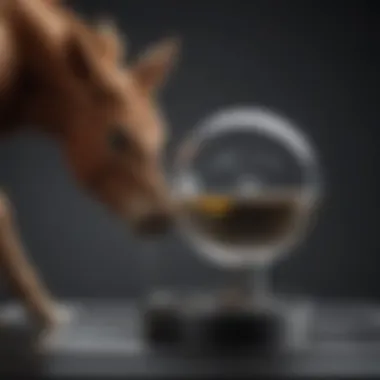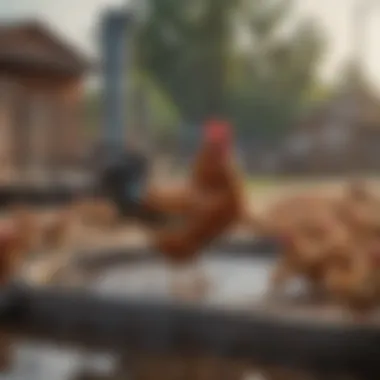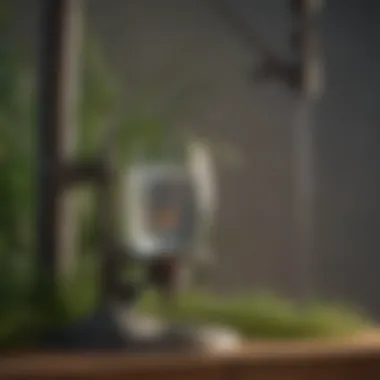Understanding the Rentacoop Waterer: A Complete Guide


Intro
The Rentacoop waterer system fundamentally changes how poultry receives drinking water. This guide examines its construction, advantages, and upkeep, while focusing on its importance for poultry health. Understanding this waterer helps poultry enthusiasts and farmers improve their livestock management practices efficiently.
Fascinating Facts About Poultry
Unique Characteristics
Poultry encompasses a variety of bird species, such as chickens, ducks, and turkeys. These birds exhibit several unique features that contribute to their survival and adaptability in different environments. Poultry have a keen sense of smell, which they use to forage for food and detect predators. Additionally, they possess a remarkable ability to regulate their body temperature, which is crucial for their well-being.
Extraordinary Abilities
Poultry communicate with each other using a range of vocalizations, which can convey emotions and alert their flock to danger. Chickens, for example, have specific sounds for different threats, allowing for rapid response to potential dangers. Moreover, they exhibit social hierarchies and establish pecking orders, illustrating their complex social structures.
Benefits of the Rentacoop Waterer
The Rentacoop waterer offers numerous benefits that support the health of poultry. It provides a continuous supply of clean water, ensuring that birds stay hydrated. Accessible drinking water is vital for optimal growth, egg production, and overall well-being.
- Reduced Contamination: The design minimizes the risk of water contamination from dirt, debris, or waste.
- User-Friendly: Easy assembly and maintenance make it a suitable option for both novice farmers and seasoned poultry enthusiasts.
- Cost-Effective: The durability of the materials ensures long-term use, minimizing replacement costs.
Proper hydration directly influences the immune systems of poultry, translating to healthier birds overall. This fact alone emphasizes the need for reliable water access.
Assembly Instructions
While setup may seem daunting, the Rentacoop waterer comes with clear instructions. Follow these steps for optimal assembly:
- Unpack all components from the box.
- Identify the waterer base, reservoir, and nozzles.
- Assemble the base and secure it to the reservoir.
- Attach the nozzles to ensure proper water flow.
- Test the waterer by filling the reservoir and checking for leaks.
Maintenance Tips
Maintaining the Rentacoop waterer is essential for longevity and efficiency. Here are some key maintenance suggestions:
- Regularly clean the waterer to prevent algae growth.
- Inspect all connections for leaks.
- Replace any worn or damaged parts promptly.
Culmination
In summary, understanding the Rentacoop waterer is crucial for poultry care. Its thoughtful design enhances access to water, which translates to healthier birds and improved productivity. By implementing proper assembly and maintenance techniques, poultry farmers can ensure their flock's well-being while enjoying the benefits of this innovative waterer.
Prologue to Rentacoop Waterer
The Rentacoop Waterer represents a significant advancement in the way poultry is provided fresh drinking water. Proper hydration is crucial for poultry health and productivity. Without adequate access to clean water, birds can experience various health issues, ranging from decreased egg production to severe physical ailments. Thus, understanding the Rentacoop Waterer becomes essential not just for poultry farmers but also for hobbyists who are invested in promoting healthy livestock.
Overview of Poultry Watering Needs
Poultry requires a consistent supply of clean water, essential for their overall health. Access to fresh water influences their growth, behavior, and productivity. As such, managing this need is not a trivial task. Factors like temperature, age of birds, and the environment can influence their water consumption. It also has significant impacts on feed conversion rates and general welfare. When birds have ready access to clean water, they demonstrate better weight gain and improved egg-laying rates. These elements underline the necessity for effective watering systems in poultry husbandry.


Prelims to Rentacoop
Rentacoop, a brand recognized for innovative poultry equipment, has focused on developing solutions that enhance poultry hydration. The Rentacoop Waterer stands out due to its thoughtful design and functionality. With its capabilities tailored to meet the specific needs of poultry, it ensures that birds have continuous access to water without contamination. Further examination of this product will reveal how it aligns with the broader goals of sustainable and efficient poultry management. By equipping farmers and poultry enthusiasts with the right tools, Rentacoop plays a pivotal role in advancing poultry care standards.
Features of the Rentacoop Waterer
The Rentacoop Waterer is designed specifically to meet the unique watering needs of poultry. Understanding its features is crucial for poultry enthusiasts and farmers, as these aspects significantly impact the health and efficiency of poultry management. The design, material choices, and capacity of the waterer work together to ensure that birds have access to clean water. This helps in promoting overall poultry health and welfare.
Design Specifications
The design of the Rentacoop Waterer reflects thoughtful engineering. It includes a valve system that minimizes water waste and prevents contamination. The shape is typically cylindrical, allowing for ease of filling and dispensing. This means the waterer can maintain a steady water level, ensuring that the birds can drink whenever they need. The height of the waterer is adjustable, making it suitable for different sizes of poultry. Such adaptability is essential for accommodating various bird types and their growing needs.
Material Composition
Material choice is paramount when it comes to poultry watering systems. The Rentacoop Waterer is primarily made from durable plastic that is resistant to both UV rays and cracks. This means the waterer can survive changing weather conditions without degrading. Additionally, some versions may include stainless steel components, adding to their longevity. These materials not only ensure durability but also make the waterer easy to clean, which is vital for maintaining hygiene and preventing disease spread among poultry.
Capacity and Size Options
The Rentacoop Waterer comes in multiple sizes, catering to different flock sizes and needs. Small options may hold a few gallons, suitable for small backyard flocks. Conversely, larger variants can accommodate extensive commercial operations that require more substantial water reserves. The capacity influences how often the waterer needs to be refilled, which can save time during busy farming days. Farmers should consider their poultry population and choose the appropriate size to ensure consistent hydration.
Choosing the right features in a poultry water system can significantly impact the health and productivity of the flock.
Benefits of Using Rentacoop Waterer
The Rentacoop waterer system serves as a pivotal tool for poultry management. Understanding its benefits not only informs poultry enthusiasts but also aids in making conscious decisions for healthier livestock care. The advantages of using the Rentacoop waterer are manifold, and they encompass aspects of poultry health, sustainable water management, and user convenience.
Enhancing Poultry Health
One of the primary benefits of the Rentacoop waterer is its positive impact on poultry health. Clean water is essential for optimal growth, egg production, and overall well-being of birds. The design of the Rentacoop waterer minimizes contamination risks, ensuring that chickens have consistent access to fresh water. This is vital, especially in hot weather when poultry can easily become dehydrated.
Moreover, the system’s ability to maintain water level helps prevent stress among birds. Stress can lead to decreased immunity, making poultry more susceptible to diseases. By maintaining an adequate supply of clean water, the Rentacoop waterer supports the immune systems of the birds, contributing to better health outcomes.
Water Conservation Techniques
In an era where water conservation is crucial, the Rentacoop waterer stands out for its efficient design. Traditional watering methods often result in significant waste, as birds may spill or contaminate their water. The Rentacoop waterer minimizes such waste by employing a gravity-fed system that reduces overflow and prevents soiling.
Implementing water conservation techniques is beneficial not just for the environment, but also for poultry farmers' bottom line. With less water wasted, there are tangible cost savings. Furthermore, conserving water can lead to better utilization of natural resources, making this system sustainable for the long run.
Ease of Use
User convenience is another critical factor that differentiates the Rentacoop waterer from other systems. The assembly is straightforward, requiring minimal tools and effort, which makes it accessible for all skill levels. Once set up, maintaining the waterer is equally uncomplicated. The refillable nature of this waterer allows for less frequent maintenance.
Additionally, the waterer is designed to be lightweight and portable, allowing farmers to move it as needed for optimal placement. This flexibility is essential for adapting to changes in weather or farm management strategies.
“A reliable watering system not only supports animal health but also enhances farm efficiency.”


Assembly Instructions for the Rentacoop Waterer
Understanding how to properly assemble the Rentacoop waterer is crucial. A well-assembled waterer ensures that your poultry receives fresh water efficiently. The assembly process can also directly impact the longevity and performance of the system. Clear instructions help prevent damage during setup and promote optimal usage once it is operational.
Step-by-Step Assembly Guide
Assembling the Rentacoop waterer may seem daunting at first, but it can be broken down into manageable steps. Here’s how to go about it:
- Gather Components: Start by laying out all the parts. This typically includes the base, the water tank, the lid, and any filters or hoses.
- Attach Base to Tank: Align the base with the designated openings on the tank. Press down firmly until they click into place.
- Secure the Lid: Place the lid on top of the tank. Ensure it fits snugly to avoid spills and contamination.
- Install Additional Features: If your model includes a filter or any additional components, install these according to the manufacturer’s instructions.
- Check Connections: Ensure all parts are securely attached and no pieces are loose. This step is essential for preventing leaks.
- Perform a Test Run: Fill the tank with water and observe for any leaks or issues. Confirm that water dispenses correctly before introducing it to your poultry.
Following these steps closely will help you set up the Rentacoop waterer effectively. Remember, patience and care during assembly are key.
Required Tools and Materials
Before you begin, it is essential to gather the right tools and materials. While the assembly of the Rentacoop waterer does not require extensive tools, a few basic items will improve efficiency:
- Flathead and Phillips Screwdrivers: For any screws that may need tightening.
- Wrench: Sometimes, parts may require the tightening of bolts.
- Cloth or Sponge: This is useful for cleaning up spills during assembly.
- Water Supply: Have a container or hose ready to fill the waterer after assembly.
By having these tools on hand before assembly begins, you will reduce the likelihood of interruptions and frustrations during the process. Each step matters, leading to a more successful poultry watering system.
Maintenance of Rentacoop Waterer
Maintaining the Rentacoop waterer is crucial for ensuring the health and well-being of poultry. Regular maintenance effectively prevents contamination and wear, prolonging the lifespan of the waterer and ensuring a consistent supply of clean water. Poultry depend on unhindered access to fresh water. Thus, neglect can lead to issues like dehydration or disease.
Taking the time to maintain this system can optimize its performance, support the birds’ health, and ultimately enhance productivity in poultry farming.
Regular Cleaning Procedures
To keep the Rentacoop waterer functioning properly, regular cleaning is essential. Cleaning should occur at least once a week, or more frequently if the waterer is being used by a large flock or in unclean conditions. Here are some steps to follow:
- Disassemble the Waterer: Start by removing all components of the waterer. This includes any removable parts like the base and cap.
- Use a Mild Detergent: Prepare a mild solution of soapy water. Avoid harsh chemicals as these can leave residues harmful to poultry.
- Scrub Thoroughly: Take a soft-bristled brush to scrub each part of the waterer. Pay particular attention to nooks and crannies where algae or dirt might accumulate.
- Rinse Well: After scrubbing, rinse all components thoroughly to remove any soap residue. This ensures that no harmful substances remain.
- Dry Completely: Be sure to let all parts air dry before reassembling the waterer. This helps prevent moisture build-up, which can promote bacterial growth.
Regular cleaning not only maintains cleanliness but also helps you identify any issues that might need fixing.
Inspecting for Wear and Tear
In addition to regular cleaning, it’s important to inspect the Rentacoop waterer for wear and tear. Over time, exposure to water and its environment can degrade the materials. Conduct a visual and physical inspection, specifically focusing on the following:
- Cracks or Leaks: Check for any visible cracks in the components. A leak can lead to water wastage and compromise the water level for poultry.
- Discoloration: Observe for any stains or discoloration as these may indicate bacterial build-up or aging materials.
- Joints and Connections: Ensure that all joints are secure and not showing signs of fatigue. Loose connections can lead to spills and inefficient water distribution.
- Fittings and Valves: If the waterer has any valves or fittings, verify their functionality. These components should open and close smoothly without resistance.
Performing these inspections periodically, especially before seasonal changes, can safeguard against larger issues down the line. Proper maintenance will keep the Rentacoop waterer reliable and efficient.
A well-maintained Rentacoop waterer supports poultry health, ensuring they have uninterrupted access to clean water, which is vital for their overall growth and productivity.
Comparative Analysis with Other Poultry Watering Systems


The comparative analysis of watering systems for poultry is a crucial aspect of understanding the advantages of the Rentacoop waterer. This section aims to underscore the various methods available, illustrating how Rentacoop stands apart in terms of efficiency, health benefits, and practical utility. Evaluating traditional practices alongside modern approaches allows poultry enthusiasts to make informed choices that benefit both their flocks and their operational practices.
Traditional Watering Methods
Traditional watering methods are typically characterized by simple designs. Many farmers have used open troughs, buckets, or even manual pouring as primary means of providing water to their birds. This method does have some advantages:
- Simplicity: These systems are easy to set up and require minimal investment.
- Accessibility: Birds can intuitively find water as it is within their natural habitat.
However, these methods present significant drawbacks, particularly concerning hygiene and efficiency. Open troughs often lead to dirty water, making it challenging to maintain cleanliness. Furthermore, the need for frequent refilling can restrict the time farmers spend on other important tasks. Traditional methods may also expose water to contamination from droppings or debris, which can affect the health of the flock.
Modern Automated Systems
In contrast, modern automated systems have emerged as a sophisticated solution. These options include nipple drinkers, pressure-driven waterers, and sensor-based refilling systems. Such systems contribute a range of benefits:
- Clean Water Supply: By delivering water directly or enclosing it within a controlled environment, contamination risks are significantly lower.
- Reduced Labor: Automated systems often require less manual intervention, streamlining the management process for farmers.
- Customization: Many modern systems allow for adjustments based on the specific needs of the poultry, enhancing their overall welfare.
Nonetheless, modern systems can also come with substantial initial costs and complexity in setup. Without proper management or maintenance, such systems might become inefficient over time. This is where Rentacoop waterer emerges as a balanced solution, offering the efficient water delivery capabilities characteristic of automated systems while remaining user-friendly and easy to maintain.
The ongoing evaluation of watering systems can lead to significant improvements in poultry health and management efficiency.
The Rentacoop waterer encapsulates the essential benefits of both traditional methods and modern automated systems. Through this analysis, it becomes evident that while traditional methods served their purpose, the shift towards automated systems has been driven by the need for increased efficiency and health benefits. The Rentacoop waterer finds its place as a practical solution amidst these methods.
Real-Life Case Studies
Real-life case studies provide tangible insights into the effectiveness and practicality of the Rentacoop waterer. These studies highlight the experiences of actual users, offering a depth of understanding far beyond theoretical concepts. They allow potential buyers to understand potential value and weigh the various benefits that could be achieved via this innovative watering system.
By sharing real user experiences, farmers and poultry enthusiasts can discern both successes and challenges encountered with the Rentacoop waterer. This understanding is invaluable. A case study could help evaluate factors like ease of installation, maintenance routines, and the immediate positive changes in poultry health. Case studies further illustrate how this waterer integrates into varying farm environments and scales of operation.
User Experiences and Testimonials
User experiences bring to the forefront the practical application of the Rentacoop waterer. Some testimonials reveal significant outcomes regarding how the system has transformed daily operations for many poultry farmers. One farmer stated, “Since using the Rentacoop waterer, I’ve noticed a marked decrease in time spent refilling waterers. My birds seem to drink more as well.” This suggests that convenience may equate to increased water intake, ultimately contributing to better health.
Positive feedback frequently notes the simplicity of the design and how it accommodates both small backyard flocks and larger commercial setups. Some user reports indicate that transitioning to the Rentacoop model diminished water waste significantly, supporting more sustainable farming practices. However, experiences don't always manifest as completely positive; some farmers expressed challenges with assembly or keeping the unit free from debris. Addressing these concerns in detail provides a more balanced view.
Impact on Poultry Farming Operations
The impact of adopting the Rentacoop waterer on poultry farming operations can be profound. Efficiency is often reported as one of the most notable advantages. Farmers do not have to frequently check and refill water stations, freeing up precious time and resources. The clean water access facilitates better hydration for the flock, which is essential for growth and productivity.
Moreover, the robust design and thoughtful material selections tend to lower instances of wear compared to traditional waterers. Consequently, maintenance costs might decrease over time.
Several case studies reveal that adopting the Rentacoop waterer has led to noticeable health improvements. Poultry farmers reported reduced incidences of illness, attributed to better hydration and cleaner water sources. Less sickness means lower costs for veterinary care and better overall productivity within the operations.
In summary, real-life case studies surrounding the Rentacoop waterer provide essential information for evaluating its performance, ease of use, and long-term benefits. These insights come from those who have experienced its practical application firsthand. Understanding these real-world implications could provide the necessary assurance for potential users to make informed decisions.
Finale and Recommendations
The exploration of the Rentacoop waterer system reveals its significant role in enhancing poultry care. This conclusion not only sums up the insights gained throughout the article but also offers actionable recommendations for farmers and poultry enthusiasts looking to implement this innovative solution.
Summarizing Key Insights
The Rentacoop waterer delivers not just water, but a methodical way to ensure that poultry have consistent access to clean drinking water. Key features include its sturdy design, easy assembly, and maintenance processes that prioritize poultry health. Moreover, the waterer's capacity and size options meet diverse farm requirements. Choosing this waterer aids in preventing water waste while catering to the hydration needs of chickens effectively. Detailed user testimonials demonstrate how implementing the Rentacoop system leads to healthier flocks and improved overall farming operations.
“Using the Rentacoop waterer transformed our daily routine, reducing the time we spent on watering while ensuring our chickens are always hydrated and healthy.”







